Cartoons – going back to the era of a whistling Mickey in Steamboat Willie – have seemed fundamental to the whole idea of movies that captured the collective consciousness in the 20th century.
So much so, that you might assume that the Oscars, going back to their founding in the late 1920s, have had a long relationship with cartoons. And you’d be right. And you’d be wrong.
Starting in 1931 at the Academy’s 5th awards, the Academy Award for animated short film category was inaugurated, under its original title, “short subjects, cartoons,” by which it was known through the end of the 1960s.
There’s a reason that, during this stretch Walt Disney became the most statue-laden person in Oscar history (at 22), for titles like The Three Little Pigs, Ferdinand the Bull, and many more. But wouldn’t a film like Snow White or Fantasia have been nominated in the feature category, way back when, too?
No they would not. The first animated film to ever be nominated for best picture was Disney’s Beauty and the Beast in 1991, back when there were still five slots. But more and more animated films were being made, and then a Disney-distributed studio named Pixar arrived in the ’90s, and with new rendered animation techniques, further upped the ante.
In 2001, 10 years after Beauty and the Beast, the best animated feature film category finally debuted. And it’s been mostly dominated by the aforementioned Pixar, ever since. As for Snow White? Aside from its music nomination, it won a special award back in 1938.
But if Walt was still pioneering the brand new idea of feature-length cartoons then, this year’s crop of nominees further pushes the envelope, once again challenging the idea of what we mean by cartoons – or animation – in the first place.
But it does that by not only looking ahead, but by honoring a range of techniques that one might assume are completely overshadowed by rendering and CGI. This year’s finalists include anime, hand-drawn abstract cartoons, a couple of essentially silent films that work without dialogue, tabletop animation – for both kids and adults – and, of course, Pixar.
Alphabetically, then, this year’s nominated crop of animated films are:
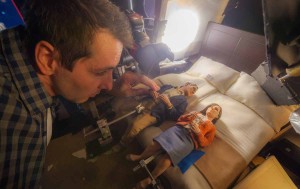
But, in fact, the entire project may be the most anomalous in the category – an R-rated stop-motion film whose themes might be more at home with the best foreign language film nominees, as they deal with existential bleakness, and the innate sadness coming from unfulfilled yearnings. There are also maquettes without clothes.
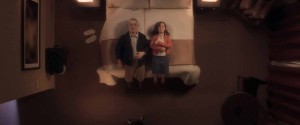 But while animating puppets may seem like one of the most retro techniques possible, as cinematographer Joe Passarelli told us, the Kickstarter-launched production wound up using 3D printers to make puppet faces with “ little dimples or striation lines,” to catch light in unplanned, and non-skin-like, ways, while camera moves with motion-control units and breakaway sets were captured digitally on a Canon 70D, to allow for tracking shots down hotel hallways and ceilings. The feel of fully-enclosed rooms is more reminiscent of how space was defined in a film like Citizen Kane, than what we’re used to seeing in tabletop animation.
But while animating puppets may seem like one of the most retro techniques possible, as cinematographer Joe Passarelli told us, the Kickstarter-launched production wound up using 3D printers to make puppet faces with “ little dimples or striation lines,” to catch light in unplanned, and non-skin-like, ways, while camera moves with motion-control units and breakaway sets were captured digitally on a Canon 70D, to allow for tracking shots down hotel hallways and ceilings. The feel of fully-enclosed rooms is more reminiscent of how space was defined in a film like Citizen Kane, than what we’re used to seeing in tabletop animation.
Passarelli also used diffusion techniques to mimic live-action lighting on those same fingernail-sized faces, to give the film an enhanced “warmth,” as he described it. “I worked on it for two years. Most of the time it didn’t feel any different than making a live-action movie,” he said.
Regardless of category, it remains one of the year’s most intriguing films.
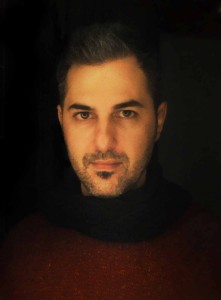
Cuca eventually takes off after him, and the simple line-based renderings and character drawings of the early part of the film yield to more intensely swirling colors, neon lights, water journeys and barrios and favelas occupied by lonely workers who commute to empty factories that are, in turn, gobbled up by voracious multinationals.
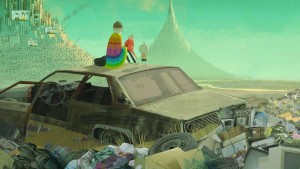
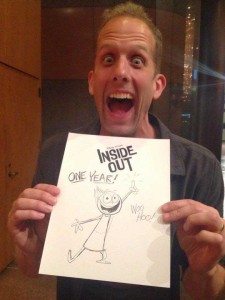
One of the goals of all that kicking is to “get as close as we can to a 1:1 shooting ratio. When you’re into animation it’s horribly expensive.” To try get as close to that elusive ratio, Pixar has its own answer to previs or animatics, making story reels that further flesh out the film. “There’s a lot of experimentation,” he said, though not usually with the voice actors, who “we record before we animate.”
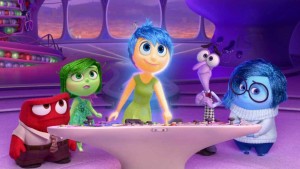
Sometimes the finished lines would be spliced from several takes – all part of the way Pixar essentially builds all its films from “the inside out.”
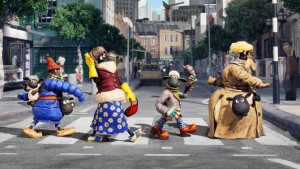
Here, the resourceful Shaun wants to give his flock a day off from early risings and sheep shearings, but as with any good comedy, an attempt to have a quiet day at home – especially one where each barnyard animal is a distinct character – goes quickly awry.
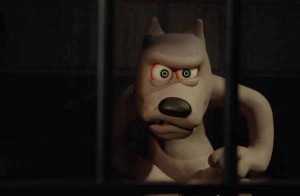 The film is silent in the same way that Boy and the World is – grunts, muttered dialogue, sounds and music fill in the aural side of the movie, but you’re not meant to listen to characters talking. Here, it’s the expressiveness of the faces, and the occasional pun (look quickly and you’ll see a cow jumping over a pub named “The Moon”), and a logic to the visual humor – sheep in human clothes, chase scenes and careening vehicles – that trace its roots not just to Aardman’s earlier work, but the visual expressiveness of silent film masters like Buster Keaton.
The film is silent in the same way that Boy and the World is – grunts, muttered dialogue, sounds and music fill in the aural side of the movie, but you’re not meant to listen to characters talking. Here, it’s the expressiveness of the faces, and the occasional pun (look quickly and you’ll see a cow jumping over a pub named “The Moon”), and a logic to the visual humor – sheep in human clothes, chase scenes and careening vehicles – that trace its roots not just to Aardman’s earlier work, but the visual expressiveness of silent film masters like Buster Keaton.
Interestingly, Aardman had tried using modern animation techniques when they rendered their 2006 film, Flushed Away, in partnership with Dreamworks, to make it look like claymation, even though it wasn’t. That film didn’t jibe nearly as well with audiences or critics, and Aardman has been happily old school ever since.
When Marnie Was There
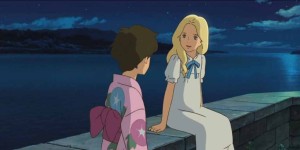
Director Hiromasa Yonebayashi and producer Yoshiaki Nishimura have adapted the late British YA author Joan G. Robinson’s 1967 novel and given it a Japanese setting. As we’ve come to expect in a Studio Ghibli outing, the visuals are lush and vivid, especially once the protagonist, 12-year-old Anna, arrives at the seaside town she’ll be summering at with relatives, as she attempts to escape the depression, and asthma, afflicting her in her foster home, back in the city.
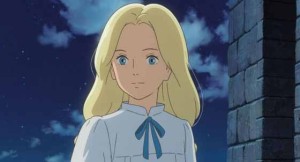 This becomes a tale of tentative friendships and suspected hauntings, and as with many of the studio’s outings, there’s a particular loss (or two) that undergirds events, leaving unrectified spirits to try and bridge past and present. While one comes to expect stunningly drawn visuals from Ghibli, in Marnie there is also an almost Douglas Sirk-like use of vivid color and settings to reflect the inner emotional landscapes of its characters.
This becomes a tale of tentative friendships and suspected hauntings, and as with many of the studio’s outings, there’s a particular loss (or two) that undergirds events, leaving unrectified spirits to try and bridge past and present. While one comes to expect stunningly drawn visuals from Ghibli, in Marnie there is also an almost Douglas Sirk-like use of vivid color and settings to reflect the inner emotional landscapes of its characters.
Sequences set on the night of the Tanabata (or Star) Festival – which here is presented in a way similar to Halloween, with masks and treats – and in a grand house that may, or may not, be haunted, are especially memorable. Besides its contribution to the visual canon of animation, Studio Ghibli once again reminds us that the emotions felt in childhood – and while coming out of it – can be just as real, and deserving of respect and exploration, as anything felt in adulthood.
Vote in Below the Line‘s Unofficial Awards Poll
[poll id=”65″]





